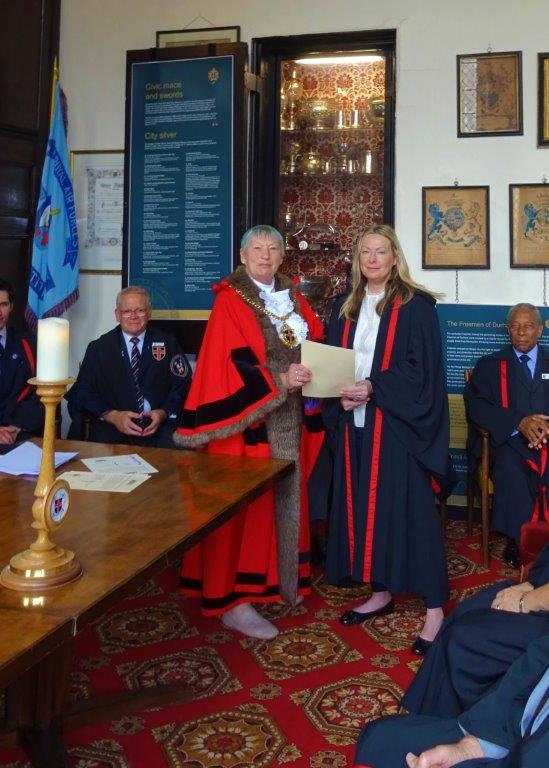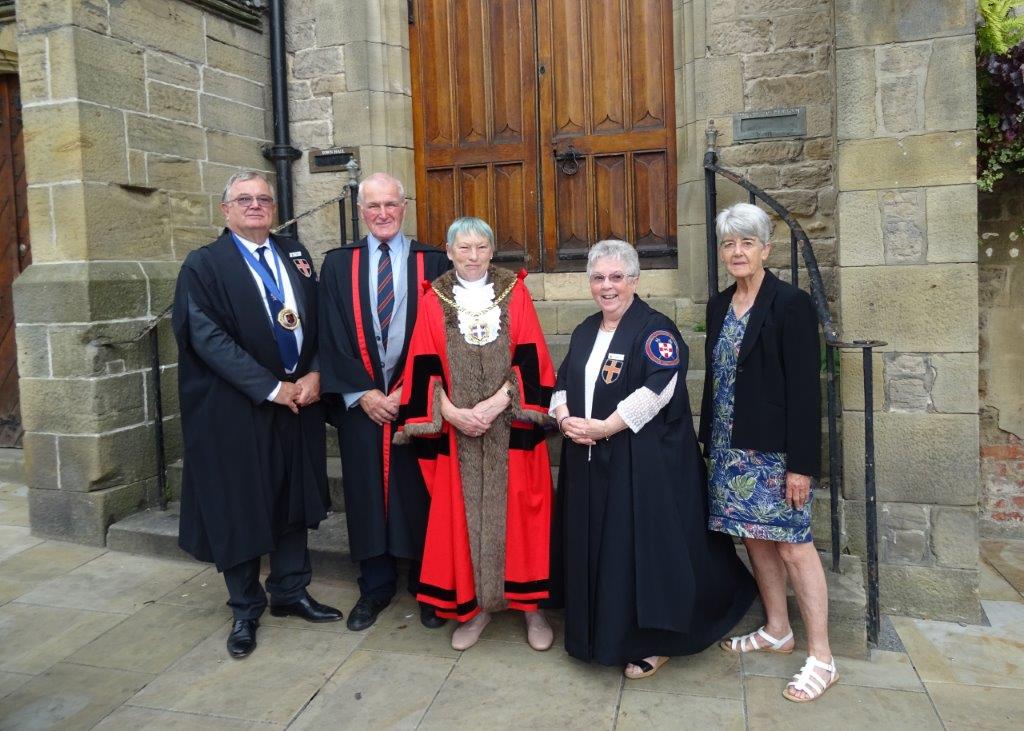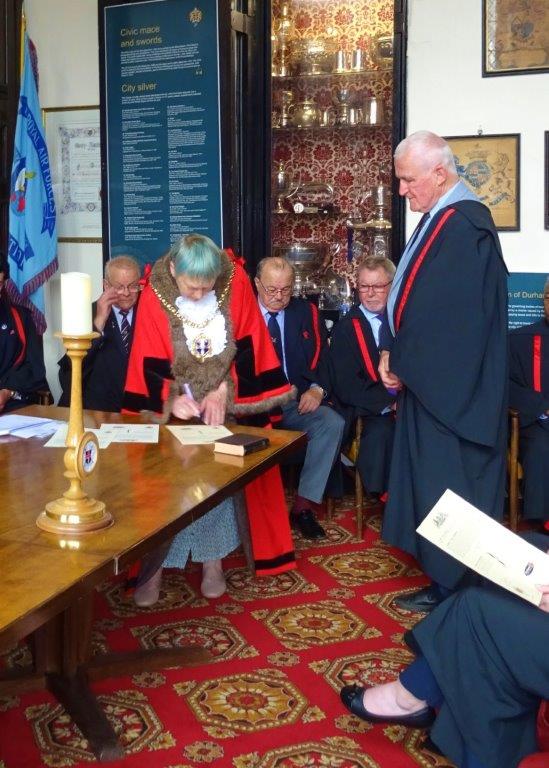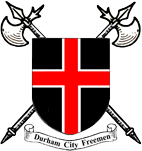
Mother-of-two Charlotte Middleton was sworn-in during an ancient Town Hall ceremony alongside Patrick Conway OBE, a retired local government director whose own career included working with the Dean and Chapter on the 900th anniversary celebrations and the public showing of the Lindisfarne Gospels. His professional and community service earned him an OBE in 2007.
Charlotte’s great-great-grandfather William Jopling, the cathedral’s joinery foreman and expert wood carver, was publicly acknowledged as “a fine English craftsman.” But events in 1898 were to put those high-quality skills to a once-in-a-lifetime test.
It all turned on a project to re-construct St Cuthbert’s original wooden coffin from fragments recovered from the first 19th century opening of the tomb in the early summer of 1827. At that point the saint’s religious relics, interred with him after his death on the Farne Islands in 687 A.D., were removed to be put on publics display.
But that first operation, controversially carried without the approval of the Bishop or Dean, was criticised as “rushed and unsophisticated” by historians. Although the skeletal remains were restored to the shrine it was claimed the most important parts of the coffin’s fragments, were “thrown back into the grave in haste” before it was sealed.
The re-opening of the tomb for a second time in 1898, was a more painstaking and fully authorized examination. For the first time specialists were able to record every bone belonging to Cuthbert – establishing, among a range of things, he was five feet eight inches tall, aged between 50 and 60 and may have suffered from TB.

William and his joinery team subsequently charged with providing a new and more durable coffin and he was among of group who signed a document bearing testament to the fact they had witnessed the replacement of all the bones in the casket before it was closed on March 17, 1899.
A magnificent ornately carved wooden door was subsequently installed at the entrance to the shrine tribute as a public tribute to William’s outstanding work during his time in the cathedral.
Charlotte’s great grandfather, also called William, went on to set up a joinery business, known as Jopling Brothers, in Half Moon yard, in the shadow of the cathedral in 1921. The business was, in turn, passed on to her grandfather - the third member of the family to bear the same Christian names. His other son, Harold, a stonemason and also a freeman, later received an OBE for his work on the cathedral’s Rose window.
Her father Trevor, now 81, ran the business until he retired in 2012. During his working life he completed many restoration and conservation projects in the heart city, including work for the Dean and Chapter. He also undertook repeated work at St Oswald’s church, which included the bell tower.
Charlotte lives near the centre city with husband Peter, an IT specialist with a Newcastle-based insurance company. Daughter Holly, aged 19 who plays for a leading women’s football team, begins studies at Leeds University in September with sights set on a physiotherapy degree. The couple’s 15-year-old son, William, is still at school and plays cricket for Littletown.
“I was born and raised in Durham and grew up knowing my father and grandfather were freemen of the city. What a privilege this was and what pride it brought to our family. I was delighted when the changes in law allowed women to become freeman and have enabled me to extend our involvement to a fifth generation,” she said.

Born to Irish immigrant parents 75 years ago in Lincolnshire, Patrick went to Caistor Grammar School and then Loughborough University, after which he qualified as a chartered librarian, working in Grimsby.
A keen sportsman, Patrick played for his school and had a brief flirtation with Grimsby Town juniors. His sporting prowess served him well as an undergraduate and he later earned coaching badges.
In the autumn of 1979 he moved to Gateshead to take up a job in the borough council’s arts and libraries department and initiated their renowned public art programme. He and wife Pat, a “Cornish Maid,” moved to Gilesgate Moor the following March where the couple raised their son Stephen and daughter Rachel.
He was the borough’s departmental director when he moved to Durham County Council in 1991, following his appointment as Director of Culture and Leisure Services before retiring in 2007.
During his time with the county council he played a key role in the continued development of Bowes Museum, Beamish Museum, the establishment of the Killhope Lead Mining Centre and the opening of the Clayport Library and Millenium Square in Durham City.
Patrick’s wife was a volunteer with the Citizen’s Advice Bureau for many years and he later joined her the management committee, becoming its chair and later chair of the regional CAB. He is also a former chair of the BBC regional advisory council.
After retirement he served as a county councillor for four years until 2017, was deputy mayor of Durham City and is a former president of Durham Rotary. He is currently a member of Belmont Parish Councillor and chair of Belmont Community School governors. Over the years he has been involved with other community and arts associations, both locally and regionally.

His sporting interests continue to flourish – as a season ticket holder at Sunderland, as a life member of Durham County Cricket Club and a life-long follower of Grimsby Town.
Since 2010 he has been a member of the of Durham City Freemen’s Trustees and chairman for the last six years before retiring. He has been sworn-in as a gentleman freemen.
Patrick says he is honoured to become a freeman, while remaining proud to be a Lincolnshire “yellowbelly.” This has nothing to do with courage, although the true meaning is long disputed. Country folk say it refers to the distinctive green and yellow facings on the uniform of the former Lincolnshire Regiment, some to bacon hung until it turns yellow, while others contended it was a species of newt, eel or frog with a yellow undercarriage.

